Spring 2018 – Jerez de la Frontera is very good at using its iconic and ancient buildings as venues for art. In the thirteenth century Alcazar and Cloisters of Santo 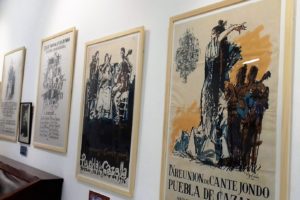 Domingo, for example, the eighteenth century Palacio Pelmartin ( which currently also houses the Central Flamenco archive ) or the sixteenth century fish market building, the Pescadaria, just off Latorre. All of these held exhibitions during the 2018 Festival de Jerez, some of which continue after it ends and are FREE to enter.
Domingo, for example, the eighteenth century Palacio Pelmartin ( which currently also houses the Central Flamenco archive ) or the sixteenth century fish market building, the Pescadaria, just off Latorre. All of these held exhibitions during the 2018 Festival de Jerez, some of which continue after it ends and are FREE to enter.
At Palacio Pelmartin there is a celebration of the life and work of Francisco Moreno Galván, artist, writer and supporter of all things flamenco. Born in the village of Cazalla in the Sierra Moreno, Galván studied first in Sevilla then in Madrid, where he had an entrée to the belle monde through his brother, who was already established there. A lifelong communist he was devoted to flamenco, the art of the people, and, most appropriately, as 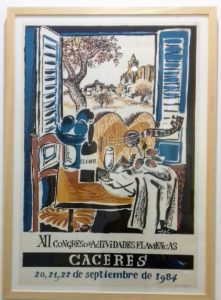 we went around the exhibition we could hear a flamenco class taking place just next door.
we went around the exhibition we could hear a flamenco class taking place just next door.
I liked very much the energy of his early posters which advertised various fiestas and festivals, most notably in Cazalla. At one point he was clearly influenced by Picasso and his work took on a more abstract quality, but he returned to the representational in his later years. He is also famous for his writings, mainly about flamenco, and his sponsorship and support of young artists. The exhibition has a selection of his pithy sayings inscribed on the classic tiles of Andalucia. Entitled Moreno Galván, Flamenco Posters and Rhymes it runs until 11th May and is FREE to enter (it is in the rooms to the right of the entrance lobby and not well sign posted, also, if you don’t speak Spanish a translation device would be useful ).
At the Palacio Villavicencio within the Alcaza, often the venue for concerts, is Carteles de Fiestas de Jerez 1868 – 2003 an exhibition of super-size 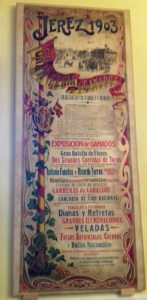 posters for Jerez festivals past. As with the Galván posters it was instructive to see how style and design changed with the passage of time. The very early posters contained large amounts of written information, framed by delicately drawn images, sometimes with one coloured larger image at the top. There are art nouveau and art deco posters, the one for 1912 could be an Alphonse Muchas. Posters for 1920s and 30s Vendemmias could be Soviet Workers Revolutionary art.
posters for Jerez festivals past. As with the Galván posters it was instructive to see how style and design changed with the passage of time. The very early posters contained large amounts of written information, framed by delicately drawn images, sometimes with one coloured larger image at the top. There are art nouveau and art deco posters, the one for 1912 could be an Alphonse Muchas. Posters for 1920s and 30s Vendemmias could be Soviet Workers Revolutionary art.
Gradually the amount of writing reduces and the posters become much more a series of seductive images 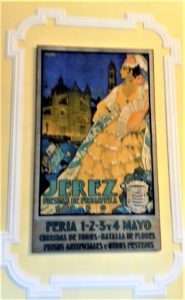 rather than a source of detailed information. I think my favourites were the very jolly young ladies who advertised the Festival in 1924 and the proudly stern, almost Egyptian looking, lady of 1930 ( also the poster for the exhibition ). The exhibition, which is supposed to be permanent, is free to enter when you buy a ticket to the Alcazar.
rather than a source of detailed information. I think my favourites were the very jolly young ladies who advertised the Festival in 1924 and the proudly stern, almost Egyptian looking, lady of 1930 ( also the poster for the exhibition ). The exhibition, which is supposed to be permanent, is free to enter when you buy a ticket to the Alcazar.
The Cloisters currently has a photographic exhibition entitled Los Vinos y Las Mujeres (Wine and Women). This is a selection of photographs of women, ranging from daughters of the Domecque and Gonzalez dynasties to grape pickers. Most heartening was the number of young women, oenologists, bodega publicity and production staff and bar owners ( I recognised Ulrike and Sabrina from Bodega El Tradicion and Luce from Tabanco Plateros ). This was most appropriate as the Festival this year had two cycles of flamenco works by women Mujeres de la Frontera and Mujeres con Nombrie Propria. This exhibition is FREE to enter, but finishes soon.
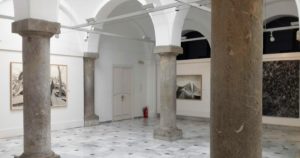 Finally, in the Pescadoria was a collective contemporary exhibition by artists from Jerez and nearby, comprising portraits, abstracts and a rather scary use of knit cloth. I liked the portraits and the squiggly abstracts. Stand well back to fully appreciate the angular abstracts which resemble single dimension renditions of Barbara Hepworth sculptures by way of Paul Nash.
Finally, in the Pescadoria was a collective contemporary exhibition by artists from Jerez and nearby, comprising portraits, abstracts and a rather scary use of knit cloth. I liked the portraits and the squiggly abstracts. Stand well back to fully appreciate the angular abstracts which resemble single dimension renditions of Barbara Hepworth sculptures by way of Paul Nash.
The marble-floored, stone vaulted building is a lovely venue and it’s worth checking it out when ever one visits Jerez, the exhibitions are usually FREE to enter, as was this one.
If you enjoyed reading this article you might also enjoy Street Art Indomitable Women Paul Nash Impressionists in London East End Vernacular


 RSS – Posts
RSS – Posts